Revision Notes: Biological Classification | Biology Class 11 - NEET PDF Download
Revision Notes: Biological Classification
Introduction to Biological Classification
Classification of living organisms has evolved from instinctive groupings based on utility (food, shelter, clothing) to scientific systems. Early attempts, like Aristotle’s classification of plants into trees, shrubs, and herbs, and animals based on red blood presence, were simple. Linnaeus introduced a Two Kingdom system (Plantae and Animalia), but it failed to distinguish between prokaryotes and eukaryotes, unicellular and multicellular organisms, or photosynthetic and non-photosynthetic ones. Modern systems consider cell structure, nutrition, reproduction, and evolutionary relationships, leading to more refined classifications.
Five Kingdom Classification
R.H. Whittaker (1969) proposed a Five Kingdom Classification: Monera, Protista, Fungi, Plantae, and Animalia, based on cell structure, body organization, mode of nutrition, reproduction, and phylogenetic relationships. This system addressed limitations of the Two Kingdom system by separating prokaryotes, unicellular eukaryotes, and fungi into distinct kingdoms.
- Table 2.1: Characteristics of the Five Kingdoms
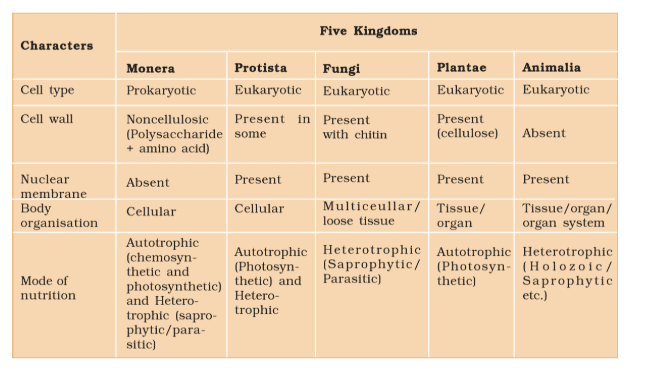
Kingdom Monera
Bacteria are the sole members of Kingdom Monera, the most abundant microorganisms, found everywhere, including extreme habitats like hot springs and deep oceans.
- Shapes: Spherical (coccus), rod-shaped (bacillus), comma-shaped (vibrium), spiral (spirillum).
- Metabolic diversity: Autotrophic (photosynthetic or chemosynthetic) or heterotrophic.
- Reproduction: Mainly by fission, sometimes spores or primitive DNA transfer (sexual).
 Bacteria of different shapes
Bacteria of different shapes
1. Archaebacteria
- Live in harsh habitats: halophiles (salty areas), thermoacidophiles (hot springs), methanogens (marshy areas).
- Unique cell wall structure enables survival in extreme conditions.
- Example: Methanogens in ruminant guts produce methane (biogas).
2. Eubacteria
- Characterized by rigid cell wall and flagellum (if motile).
- Cyanobacteria (blue-green algae): Photosynthetic, unicellular/colonial/filamentous, form blooms in polluted water, some fix nitrogen (e.g., Nostoc, Anabaena).
- Chemosynthetic bacteria: Oxidize inorganic substances for energy, recycle nutrients (nitrogen, phosphorus, iron, sulfur).
- Heterotrophic bacteria: Decomposers, some beneficial (curd, antibiotics, nitrogen fixation), others pathogenic (cholera, typhoid, citrus canker).
- Mycoplasma: Smallest living cells, lack cell wall, many are pathogenic.
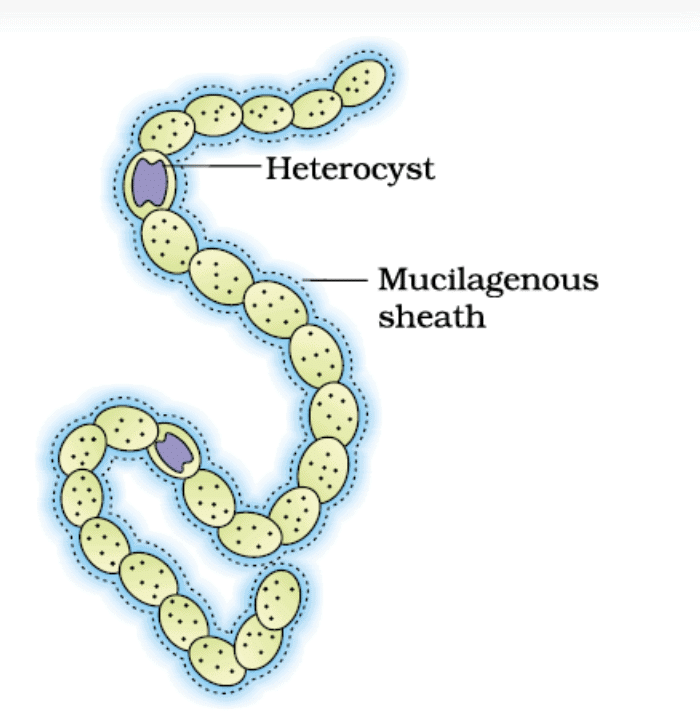
Kingdom Protista
Single-celled eukaryotes, primarily aquatic, with a defined nucleus and membrane-bound organelles. They reproduce asexually or sexually (cell fusion, zygote formation).
1. Chrysophytes
- Includes diatoms and golden algae (desmids), found in fresh/marine water, mostly photosynthetic.
- Diatoms: Cell walls with silica, form diatomaceous earth used in polishing/filtration, chief producers in oceans.
2. Dinoflagellates
- Mostly marine, photosynthetic, with cellulose plates and two flagella.
- Red tides (e.g., Gonyaulax) cause fish mortality due to toxins.
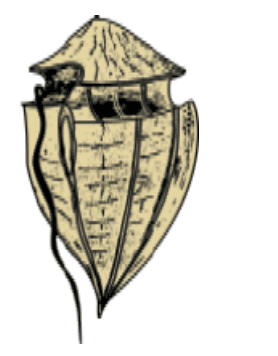
3. Euglenoids
- Freshwater, flexible due to pellicle (protein layer), two flagella.
- Photosynthetic in sunlight, heterotrophic in darkness (e.g., Euglena).
4. Slime Moulds
- Saprophytic, form plasmodium under suitable conditions, produce resistant spores in fruiting bodies.
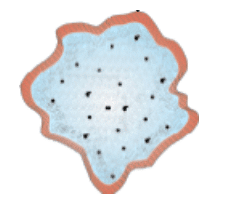
5. Protozoans
- Heterotrophic, predators or parasites, four groups:
- Amoeboid: Move via pseudopodia, some parasitic (e.g., Entamoeba).
- Flagellated: Free-living or parasitic, cause diseases like sleeping sickness (e.g., Trypanosoma).
- Ciliated: Move via cilia, have gullet for food intake (e.g., Paramoecium).
- Sporozoans: Infectious spore stage, cause malaria (e.g., Plasmodium).
Kingdom Fungi
Heterotrophic, diverse in morphology and habitat, mostly filamentous (hyphae forming mycelium), with chitin cell walls. They are saprophytic, parasitic, or symbiotic (lichens, mycorrhiza).
- Reproduction: Vegetative (fragmentation, fission, budding), asexual (conidia, sporangiospores, zoospores), sexual (oospores, ascospores, basidiospores).
- Sexual cycle: Plasmogamy, karyogamy, meiosis; dikaryophase in some (ascomycetes, basidiomycetes).
1. Phycomycetes
- Aquatic or on decaying wood, aseptate coenocytic mycelium.
- Asexual: Zoospores or aplanospores; Sexual: Zygospores (e.g., Mucor, Rhizopus, Albugo).
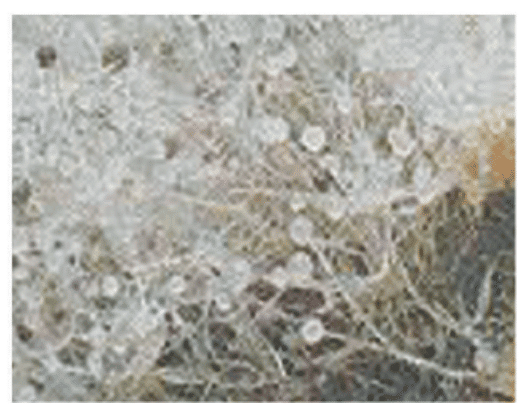
2. Ascomycetes
- Sac-fungi, mostly multicellular, saprophytic/parasitic.
- Asexual: Conidia; Sexual: Ascospores in asci within ascocarps (e.g., Aspergillus, Neurospora).
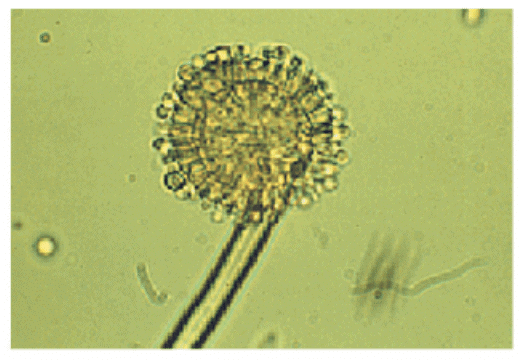
3. Basidiomycetes
- Mushrooms, rusts, smuts; septate mycelium, no asexual spores.
- Sexual: Basidiospores in basidia within basidiocarps (e.g., Agaricus, Puccinia).
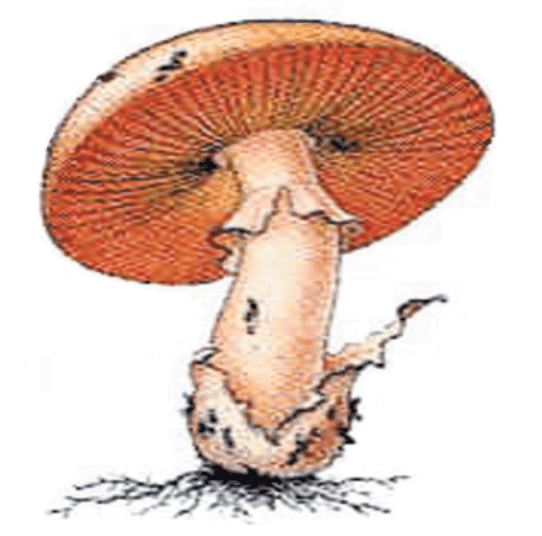
4. Deuteromycetes
- Imperfect fungi, only asexual (conidia), saprophytic/parasitic, decomposers (e.g., Alternaria, Trichoderma).
Kingdom Plantae
Eukaryotic, chlorophyll-containing organisms (plants), with cellulose cell walls. Includes algae, bryophytes, pteridophytes, gymnosperms, angiosperms.
- Some partially heterotrophic: Insectivorous (Bladderwort, Venus fly trap), parasitic (Cuscuta).
- Life cycle: Alternation of generations (diploid sporophytic, haploid gametophytic).
Kingdom Animalia
Heterotrophic, multicellular eukaryotes without cell walls, holozoic nutrition, store glycogen/fat, definite growth pattern, most capable of locomotion, sexual reproduction via copulation.
Viruses, Viroids, Prions, and Lichens
Not included in Whittaker’s five kingdoms.
- Viruses: Non-cellular, inert crystalline outside host, obligate parasites with RNA or DNA, cause diseases (mumps, AIDS, mosaic in plants). Examples: TMV, bacteriophage.
- Viroids: Free RNA, no protein coat, cause diseases like potato spindle tuber.
- Prions: Abnormally folded proteins, cause diseases like mad cow disease, CJD.
- Lichens: Symbiotic algae (phycobiont) and fungi (mycobiont), pollution indicators.
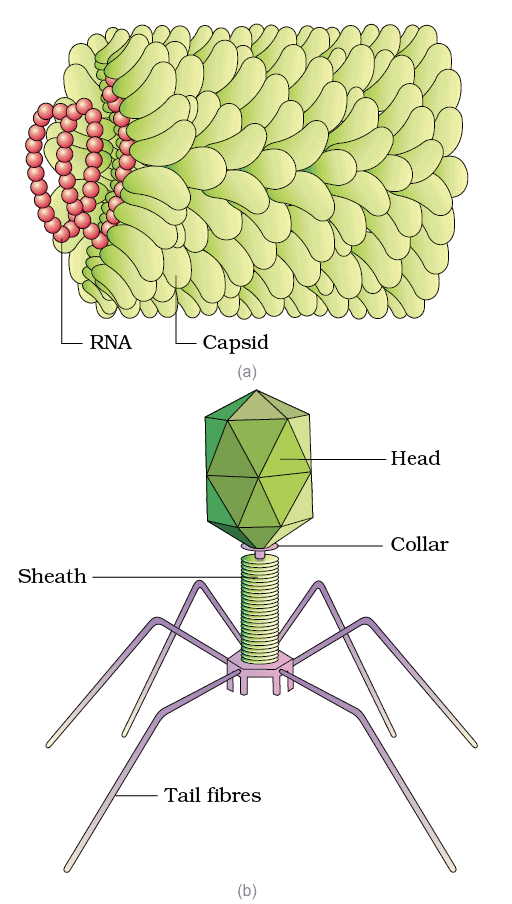
a) Tobacco Mosaic Virus (TMV) (b) Bacteriophage
Summary
Aristotle and Linnaeus laid early foundations for classification, but Whittaker’s Five Kingdom system (Monera, Protista, Fungi, Plantae, Animalia) is based on cell structure, nutrition, and phylogeny. Monera includes prokaryotic bacteria, Protista includes single-celled eukaryotes, Fungi are heterotrophic with chitin walls, Plantae are autotrophic with cellulose walls, and Animalia are heterotrophic multicellular organisms. Viruses, viroids, prions, and lichens are not classified in this system.
|
150 videos|401 docs|136 tests
|
FAQs on Revision Notes: Biological Classification - Biology Class 11 - NEET
| 1. What are the main characteristics used for the classification of living organisms? |  |
| 2. What are the major kingdoms in the biological classification system? |  |
| 3. How does the binomial nomenclature system work? |  |
| 4. Why is biological classification important for understanding organisms? |  |
| 5. What role do phylogenetic trees play in biological classification? |  |

















